Blog
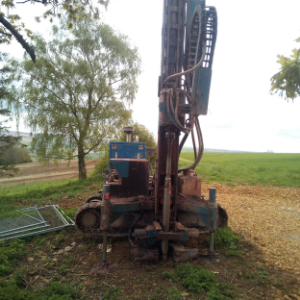
A Guide to Borehole Drilling for Ground Source Heat Pumps
Posted on 29 July 2021 in Blog
If you're considering installing a ground source heat pump, you may have a lot of questions about the process - particularly when it comes to the groundworks and drilling boreholes. Below you'll find information about each of the stages involved with borehole drilling which will provide you with a clearer understanding of what expect when it comes to your own ground source heat pump installation.
Preparation
Before we drill any boreholes, it is recommended that checks are made to see if planning consent is required from your local planning authority. In the majority of cases, planning consent will already exist under permitted development provisions. Sometimes however, local restrictions may apply if, for example, the site is in a Conservation Area, a Site of Special Scientific Interest (SSSI) or in a National Park.
Getting Started
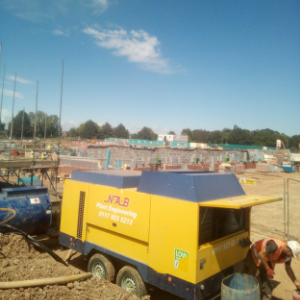
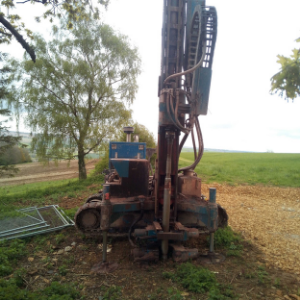
(Images left to right: Compressor, Drilling Rig)
When the drilling team arrives, they will be in one or two crew vehicles, the drilling rig will arrive on a lorry transporter together with a large compressor and various other smaller items of equipment. The drilling rig is on rubber tracks, but it weighs around the same as five standard cars, so it will create some marks and ruts on soft surfaces such as grass – especially in wet conditions. The compressor is about the size of a small caravan and weighs the same as a small car. It needs to be parked as close to the drilling rig as possible. Drilling boreholes is quite a significant civil engineering project and process, therefore there will be disruption to the area. As the drill works into the ground it will pass through the soil and into the rock below. To stop the borehole sides from collapsing, we insert metal casing into the hole, down as far as required. Our quotes / proposals typically includes for the first 15m (50ft). If metal casing is still required below this depth it will be added as an additional charge. Unfortunately, it is not possible to know how much casing is required until we start drilling but generally 15m is sufficient.
Water
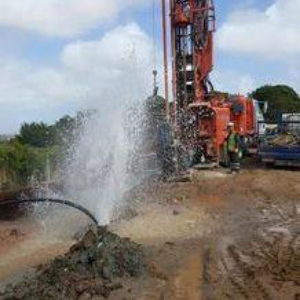
(Image: Water coming from borehole)
We require and use water during the drilling process (we do need you to have a good water supply for our use), we will almost always hit water whilst drilling at some point / depth. The volumes involved can be considerable, as the water includes soil and aggregates from the borehole. Legislation dictates it must be treated as foul water rather than clean water. Ideally we try to discharge the water to a nearby area of ground where it can safely soak away. However, where this is not possible, we will try to divert the flow to a foul drain (discharge license required) or in extreme cases, arrange for it to be contained and transported from site. Where additional permissions or costs are incurred for water disposal, these will be charged as an extra to our original quote.
Sand and Spoil
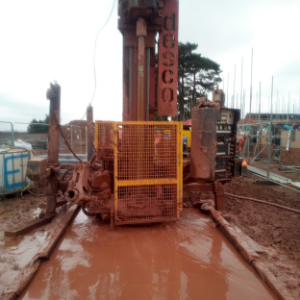
(Image: Sump filled with spoil)
In addition to water, the drilling will produce a wet aggregate of broken rock and soil from the borehole – generally about 1.5 tonnes of aggregate per 100m of depth. Unless otherwise stated, disposal of this spoil is the responsibility of the customer. In practice, most customers find the spoil is a useful backfill for the trenches, that are required to connect the borehole pipework to the manifold and heat exchanger. Alternatively, the ground worker removes the spoil at the same time as digging the trenches required to connect the pipework to the manifold. When drilling is completed, geothermal loops (also known as probes) are inserted down the boreholes. To ensure they extract as much warmth from the ground as possible, the space around the loops / probes are filled with a mixture of sand and bentonite clay to prevent any air gaps in the borehole. The sand is delivered in 1 tonne bags, if any sand is left over after filling the boreholes, this is left on site for the customer. Normally any surplus sand is used to bed the pipework connecting the boreholes to the manifold and heat exchanger, protecting the pipes from damage by sharp rocks etc.
After Drilling
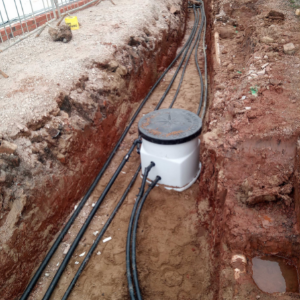
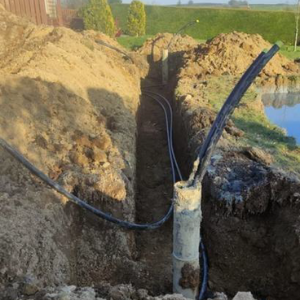
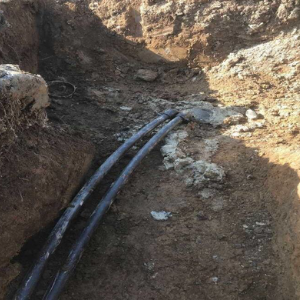
(Images from left to right: Manifold chamber, trench system between boreholes, finished borehole with pipes running into trench)
Once the boreholes are completed, the geothermal loops / probes have been inserted and the boreholes packed to exclude air gaps, the pipework will be left protruding above ground level. This is just a temporary measure. Your installer / the groundworker will excavate a hole around each borehole which is2ft deep hole and 3ft wide, we will then cut off the outer metal casing and attach pipes to the geothermal loops. These pipes will be laid underground to the manifold chamber, the area of the borehole can then be backfilled, leaving no sign above ground of its existence. The manifold chamber collects the pipes from the boreholes and via 2 header pipes, the energy is transferred to the heat exchanger / heat pump. The manifold chamber is covered by a lid similar in size to a drain cover. Many customers disguise this lid with, for example, pots of flowers or shrubs or hide it under garden furniture. Unless otherwise agreed, your installer / groundworker is responsible for laying the pipes from the boreholes to the manifold, installing the manifold and installing the pipes from the manifold to the heat exchanger. We can supply a drawing and specification of the requirements. We need two access points to the plant room, 500mm apart and sweeping bends (ensure ONLY SWEPT BENDS are USED) to enable us to get pipe work into the plant room. Your installer / ground worker is responsible for providing the access points and for all remedial works afterwards including re-instatement of the borehole area. After drilling the area will be a mess due to the tracks from the drilling rig and compressor as well as the spoil (sand, grout and water).
You may also find it helpful to view our video of a 100m borehole being drilled in a carpark, to see the spoil which can emerge whilst drilling.
FURTHER READING
How Much Space is Needed for a Ground Source Heat Pump?
Different Types of Ground Collectors
 Facebook
Facebook LinkedIn
LinkedIn Twitter
Twitter













